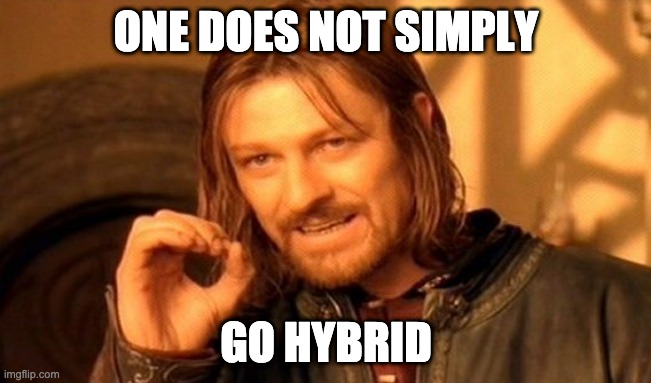Nearly everyone we talk to says they are moving to a hybrid workplace. They’ve tasted the fruit of distributed work, but aren’t ready to completely give up their office.
Most are picking (or rather avoiding picking) which hybrid business model best fits their team.
But there are a lot of unanswered questions about what it means to be a hybrid workplace. Once you define your model, you need to further clarify what hybrid work looks like.
Here are 15 questions to help you create that clarity around your hybrid workplace.
What is a hybrid workplace?
A hybrid workplace is one that blends the in-person and remote experiences. It doesn’t require team members to be in the same physical office every day, but it does expect that there are times when everyone is together. There are many variations of a hybrid workplace and many questions to answer to determine what it looks like on the ground.
Is now the best time to decide?
Working remotely in 2020 was not the same as working remotely in 2019 or (hopefully) in 2023. Normally, people can get out and socialize outside of work hours. You don’t have the stress of a pandemic weighing over you. You don’t have to wear masks everywhere.
As restrictions ease, you may need to create an interim plan for a few months to test things out. People’s desperation to get back to the office may be just a strong desire for any physical human connection.
Don’t keep your team in limbo, but don’t make a permanent policy either. Commit to one of the models for a period of time and then reevaluate with everyone’s input.
First, 8 big questions to define your hybrid workplace
1. Are you the same team you were?
How many new team members did you add through the pandemic? Or, how many did you lose? If you have new people, do they live near your office? What expectations do they have about coming every day?
You do not have the same team you did. Even if the names are the same, everyone has different expectations and experiences. Make the best decision for your current team, not your 2019 team.
2. Why do team members want to come back to the office?
What did people miss most? What have they not been able to replicate? Is it context in discussions? Or the energy of being around other people?
Do they need an escape from their home? Do they feel like they are in a rut? Do they feel ignored, unappreciated, or unaligned?
3. Why do they NOT want to come to the office?
What have they enjoyed about working from home? Avoiding the commute? Having a more flexible work schedule?
What kinds of permanent lifestyle changes do they want to make? What would change if they could work from a nearby co-working space instead of your office?
4. Why do you want people to come back to the office?
Don’t just say “our culture”. Be specific. What were you not able to replicate in the digital world? What have you found no substitute for?
What kind of biases are you bringing to the table? Are you relying on the office too much to measure productivity? Do you expect the office to create alignment, culture, and collaboration? Did you lose out on these in a digital space because you just expected them to happen on their own?
Think about your office as a new hire. What are you paying for it to do? How are you equipping it to do its job well?
5. Why do you want team members to be able to work from somewhere else?
Are they happier having more flexibility? Are they more productive? Do they seem more refreshed and less stressed? Or does it seem like something you are forced to do to retain talent?
You may need some non-pandemic time to evaluate the benefits people are getting by not coming to the office.
6. Is your HQ a place or a tool?
HQ means the central source of truth. When you really want to know what’s going on, where do you check? Do you go over to someone’s desk? Do you check a digital tool? If someone needs to get up to speed, do they need to come to the office? Or check the project management board? Or the OKR tool?
This affects how you call people who are not in the physical office. If the office is the HQ, then anyone not there is ‘remote’. If the digital tools are the HQ, then everyone is ‘distributed’, and some people are ‘co-located’.
7. How will you judge productivity?
Be very explicit about what it means to do a good job. If you are going to trust people to get work no matter where they are, show them what metrics you are looking at instead. If you use presenteeism or activity to measure productivity, then any amount of hybrid work will seem like a burden on managers.
8. How will this affect how you handle clients and customers?
How will your hybrid workplace affect your clients and customers? For some, it has absolutely no effect. But it may be huge for others. Do you need a nice office to bring clients to? Do clients need to see the busyness of the office to be put at ease?
Many of your ground rules and working agreements may be very different when team members interact with customers.
Now, 7 practical questions for your hybrid workplace
These questions get into the specifics about how your hybrid workplace will operate. The answers to these questions are dependent on what you decided earlier. Let your conclusions about your hybrid workplace help you make consistent choices.
9. How many days should people be in the office?
This could be as many as 4 per week, or as few as never. If you are going to have a physical office, how often do you want people to be there? Why do you care?
Is this a suggestion or a mandate? Are you going to track attendance?
10. Should everyone be in the office on the same days?
Was “better collaboration” the main reason people want to be back in the office? Collaboration will get worse if only 60 percent of your team is there on any given day. You might want to consider having everyone have the same days in the office.
11. Does everyone need to work the same hours?
Was a flexible schedule a popular answer to question 3? How does it impact your team if you have some people active in the early morning, and others later at night? What if someone needs to take off in the middle of the day? When can you schedule hybrid meetings?
12. Do you need to have a “highly responsive” time?
Even distributed teams have a time zone HQ that determines when you expect a quick response. You might ask people to respond within 30 minutes during that time of ‘burstiness‘. However, if a message comes in at 5pm, that can wait till the next day. This can people guard their focus mode of work.
13. Will you invest in home offices/co-working spaces?
If team members are working outside a regular HQ, how much are you going to invest into their “second office”? This could be a yearly home office stipend. Or, a subscription to a co-working space near their home.
14. How will you protect the inclusion of remote workers?
If some people work remotely more than others, there is often an unconscious bias against them. They get left out of conversations, passed over for promotions, and aren’t intentionally developed into leaders.
If you are going to offer a hybrid workplace, make sure it works for everyone. If you aren’t willing to do that work, it’s best to commit to Model 1.
15. Where should the boss be?
Every hybrid workplace defaults to where the boss is. If you are the boss and you want to offer hybrid, you must be out of the office as much as you allow anyone else. If you don’t, everything will move back to Model 1 very quickly. By staying out of the office, you will understand what it’s like for remote workers and will build systems to support them.
This is not a test
There isn’t a right answer to all these questions. Answers are dependent on your industry, the historical context of your team, and how willing you are to experiment with a hybrid workplace.
Don’t force all these decisions onto your team, but talk through them openly.
Whatever you decide, create a document that outlines your major decisions. Stick to it for a few months and then revisit it until you’ve refined a model that works for you.
Becoming a hybrid workplace is an exciting idea, but it is doomed to fail if you don’t define what it is going to look like.
Nearly everyone we talk to says they are moving to a hybrid workplace. They’ve tasted the fruit of distributed work, but aren’t ready to completely give up their office.
Most are picking (or rather avoiding picking) which hybrid business model best fits their team.
But there are a lot of unanswered questions about what it means to be a hybrid workplace. Once you define your model, you need to further clarify what hybrid work looks like.
Here are 15 questions to help you create that clarity around your hybrid workplace.
What is a hybrid workplace?
A hybrid workplace is one that blends the in-person and remote experiences. It doesn’t require team members to be in the same physical office every day, but it does expect that there are times when everyone is together. There are many variations of a hybrid workplace and many questions to answer to determine what it looks like on the ground.
Is now the best time to decide?
Working remotely in 2020 was not the same as working remotely in 2019 or (hopefully) in 2023. Normally, people can get out and socialize outside of work hours. You don’t have the stress of a pandemic weighing over you. You don’t have to wear masks everywhere.
As restrictions ease, you may need to create an interim plan for a few months to test things out. People’s desperation to get back to the office may be just a strong desire for any physical human connection.
Don’t keep your team in limbo, but don’t make a permanent policy either. Commit to one of the models for a period of time and then reevaluate with everyone’s input.
First, 8 big questions to define your hybrid workplace
1. Are you the same team you were?
How many new team members did you add through the pandemic? Or, how many did you lose? If you have new people, do they live near your office? What expectations do they have about coming every day?
You do not have the same team you did. Even if the names are the same, everyone has different expectations and experiences. Make the best decision for your current team, not your 2019 team.
2. Why do team members want to come back to the office?
What did people miss most? What have they not been able to replicate? Is it context in discussions? Or the energy of being around other people?
Do they need an escape from their home? Do they feel like they are in a rut? Do they feel ignored, unappreciated, or unaligned?
3. Why do they NOT want to come to the office?
What have they enjoyed about working from home? Avoiding the commute? Having a more flexible work schedule?
What kinds of permanent lifestyle changes do they want to make? What would change if they could work from a nearby co-working space instead of your office?
4. Why do you want people to come back to the office?
Don’t just say “our culture”. Be specific. What were you not able to replicate in the digital world? What have you found no substitute for?
What kind of biases are you bringing to the table? Are you relying on the office too much to measure productivity? Do you expect the office to create alignment, culture, and collaboration? Did you lose out on these in a digital space because you just expected them to happen on their own?
Think about your office as a new hire. What are you paying for it to do? How are you equipping it to do its job well?
5. Why do you want team members to be able to work from somewhere else?
Are they happier having more flexibility? Are they more productive? Do they seem more refreshed and less stressed? Or does it seem like something you are forced to do to retain talent?
You may need some non-pandemic time to evaluate the benefits people are getting by not coming to the office.
6. Is your HQ a place or a tool?
HQ means the central source of truth. When you really want to know what’s going on, where do you check? Do you go over to someone’s desk? Do you check a digital tool? If someone needs to get up to speed, do they need to come to the office? Or check the project management board? Or the OKR tool?
This affects how you call people who are not in the physical office. If the office is the HQ, then anyone not there is ‘remote’. If the digital tools are the HQ, then everyone is ‘distributed’, and some people are ‘co-located’.
7. How will you judge productivity?
Be very explicit about what it means to do a good job. If you are going to trust people to get work no matter where they are, show them what metrics you are looking at instead. If you use presenteeism or activity to measure productivity, then any amount of hybrid work will seem like a burden on managers.
8. How will this affect how you handle clients and customers?
How will your hybrid workplace affect your clients and customers? For some, it has absolutely no effect. But it may be huge for others. Do you need a nice office to bring clients to? Do clients need to see the busyness of the office to be put at ease?
Many of your ground rules and working agreements may be very different when team members interact with customers.
Now, 7 practical questions for your hybrid workplace
These questions get into the specifics about how your hybrid workplace will operate. The answers to these questions are dependent on what you decided earlier. Let your conclusions about your hybrid workplace help you make consistent choices.
9. How many days should people be in the office?
This could be as many as 4 per week, or as few as never. If you are going to have a physical office, how often do you want people to be there? Why do you care?
Is this a suggestion or a mandate? Are you going to track attendance?
10. Should everyone be in the office on the same days?
Was “better collaboration” the main reason people want to be back in the office? Collaboration will get worse if only 60 percent of your team is there on any given day. You might want to consider having everyone have the same days in the office.
11. Does everyone need to work the same hours?
Was a flexible schedule a popular answer to question 3? How does it impact your team if you have some people active in the early morning, and others later at night? What if someone needs to take off in the middle of the day? When can you schedule hybrid meetings?
12. Do you need to have a “highly responsive” time?
Even distributed teams have a time zone HQ that determines when you expect a quick response. You might ask people to respond within 30 minutes during that time of ‘burstiness‘. However, if a message comes in at 5pm, that can wait till the next day. This can people guard their focus mode of work.
13. Will you invest in home offices/co-working spaces?
If team members are working outside a regular HQ, how much are you going to invest into their “second office”? This could be a yearly home office stipend. Or, a subscription to a co-working space near their home.
14. How will you protect the inclusion of remote workers?
If some people work remotely more than others, there is often an unconscious bias against them. They get left out of conversations, passed over for promotions, and aren’t intentionally developed into leaders.
If you are going to offer a hybrid workplace, make sure it works for everyone. If you aren’t willing to do that work, it’s best to commit to Model 1.
15. Where should the boss be?
Every hybrid workplace defaults to where the boss is. If you are the boss and you want to offer hybrid, you must be out of the office as much as you allow anyone else. If you don’t, everything will move back to Model 1 very quickly. By staying out of the office, you will understand what it’s like for remote workers and will build systems to support them.
This is not a test
There isn’t a right answer to all these questions. Answers are dependent on your industry, the historical context of your team, and how willing you are to experiment with a hybrid workplace.
Don’t force all these decisions onto your team, but talk through them openly.
Whatever you decide, create a document that outlines your major decisions. Stick to it for a few months and then revisit it until you’ve refined a model that works for you.
Becoming a hybrid workplace is an exciting idea, but it is doomed to fail if you don’t define what it is going to look like.
)
)
)







